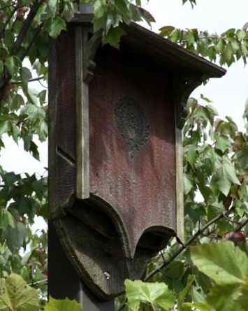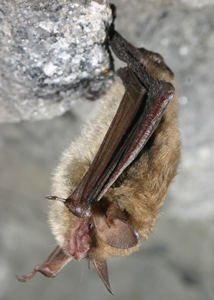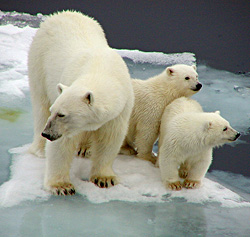-
These Guys Use Bat Houses too – Please Advocate for Them
Almost eight years later and we’re still dealing with the mysterious fungus known as white nose syndrome which is critically affecting the bat population. Originating in the northeastern US, it’s continually spreading further west and south. Although it may seem trivial to some, the furry, winged mammals (yes they’re mammals) play a key role in the eco-system… especially to farmers and their crops.
A little cl
oser to home, as in our own backyards, bats help control insect populations with behavior that for the most part, goes unnoticed. They just happen to be some of our major pollinators too!
By offering shelter in the form of bat houses, you’ll encourage the critters to stick around. Several species are known to use the houses for roosting, and the shelters range in size from a single chamber to larger 5-chamber models. There’s even designer bat houses to enhance your landscape!
If you can spare 60 seconds, please see the quick note below from the Center for Biological Diversity, and take a stand for bats… thanks!
Since 2006 a deadly fungal disease called white-nose syndrome has killed nearly 7 million North American bats, pushing several species to the brink of extinction and creeping farther across the country every year.
But at least one of these species may get big help from the feds: The U.S. Fish and Wildlife Service has proposed to protect northern long-eared bats under the Endangered Species Act.
These bats have declined by 98 percent over a large portion of their range, and have been waiting a painfully long time for an emergency rescue. But — just as life-saving protections are in sight — the Service’s proposal to protect the creatures could be derailed by greedy energy companies, who are lining up to limit the bat’s protection.
Please take action now to tell the Fish and Wildlife Service to protect northern long-eared bats without delay. If we wait any longer, it may well be too late.
-
Alaska, Salazar Team Up to Kill Polar Bears
Alaska just took its brutal war against the polar bear to a new level.
The state was already in court to strip federal protection from the polar bear, but last week it launched a new attack — on the bear’s habitat. It filed a legal notice to strike down the federal government’s designation of a 120-million-acre polar bear reserve along Alaska’s northern coast.
This is the largest imperiled species habitat reserve in history — bigger than 48 of the 50 states — and protecting it is essential to the survival of the polar bear.
The Center for Biological Diversity has just a few weeks to prepare to beat back Alaska’s new antiwildlife lawsuit, and we need to raise the funds now to do it. Please, help us save the polar bear and the largest habitat reserve in history: Donate today to our Endangered Species Action Fund. A Center donor will triple-match any gift made by Dec. 31, so your donation will be worth three times as much.
Just four days to triple your gift and save polar bears.
The Center has been leading the charge to save polar bears since 2005. We got the majestic white bears placed on the federal list of “threatened species,” we stopped oil drilling in their habitat and we won the 120-million-acre habitat reserve earlier this year.
We’ve been fighting for years to stop Alaska’s bid to strip federal protection from the polar bear. And with your help today, we’ll be in court again in just two months to stop the state’s effort to eradicate the bears’ habitat reserve as well.
Help us win the looming legal battle to save the polar bear’s habitat by making a generous emergency gift to our Endangered Species Action Fund by the end of the year. Now is the best time to do it, since a Center supporter will make your gift worth three times as much by triple-matching donations made by Dec. 31.
The Center doesn’t spend its money mailing wolf and polar bear plush toys. We don’t offer calendars and tote bags. We spend our members’ donations protecting endangered species, period. And we win: Our 93 percent success rate in the courts is unparalleled in the environmental movement. So is our protection of more than 500 species and 230 million acres of wildlife reserves.
Unfortunately, Alaska isn’t the only one attacking polar bears. Last week Interior Secretary Ken Salazar made two stunning decisions that could drive the polar bear extinct if we don’t stop him as well.
In lock-step with Bush administration policies already struck down by the courts, first Salazar opened up huge areas of polar bear habitat to offshore oil drilling — despite the devastating spill impacts we saw in the Gulf of Mexico — and then he refused to upgrade the polar bear’s legal status from “threatened” to “endangered.” Withholding full protection from the polar bear gives Salazar an excuse for not stopping fossil fuel pollution from coal-fired power plants that are driving the species extinct.
But with your generous support and our 20-plus years of winning life-saving results for endangered wildlife, the Center will take on Alaska and Salazar at the same time, saving the polar bear and its precious, disappearing habitat.
P.S. Your generous gift truly makes a difference when you give to the Center and keep our expert staff on the front lines of the most critical battles for the survival of species — like the polar bear in Alaska. For only the next four days, a Center donor will match your gift, making it worth three times as much. Please give to our Endangered Species Action Fund by Dec. 31 and encourage your friends and family to join this life-saving, planet-saving effort.
P.P.S. If you prefer to make your gift by mail, send a check to the Center for Biological Diversity, PO Box 710, Tucson, AZ 85702 — or to give by phone, call toll-free 1-866-357-3349 x 316. Thank you for your support.
Polar bear photo by Pete Spruance.
. When donating online to the Center for Biological Diversity, always confirm that the donation page is located at DemocracyinAction.org or BiologicalDiversity.org.
Center for Biological Diversity
P.O. Box 710
Tucson, AZ 85702
1-866-357-3349
www.BiologicalDiversity.org -
So you don’t believe in global warming?
Global Warming Is Happening Right Here, Right Now
Graphic Video Shows Polar Bears Starving to Death in Hudson BayWarning: This video includes disturbing footage of a malnourished polar bear mother and her two cubs in western Hudson Bay, Canada. Some may choose not to watch, because it includes graphic scenes of a malnourished cub experiencing seizures.
Both cubs died within two days of the November 23, 2010, filming.
As difficult as the images are to watch, they show the real-life struggle polar bears face each day trying to survive on a warming planet. Malnourishment, starvation and even cannibalism have become facts of life for polar bears in western Hudson Bay and other areas.A Warming Climate Takes its Toll on the Polar Bears of Hudson Bay. from Daniel J. Cox on Vimeo.
© 2010 Daniel J. Cox/NaturalExposures.com
Polar bears are completely dependent upon large expanses of sea ice to hunt, feed and survive. They use the sea ice as a platform to capture seals and other prey. Global warming is rapidly melting their ice and lengthening the ice-free season, forcing bears to spend ever-longer periods of time on land, where there is little for them to eat. The longer bears like the ones in this video are stranded on land, the more likely they are to starve.
Polar bears were listed as a threatened species under the U.S. Endangered Species Act in 2008 due to sea-ice declines and dwindling populations. The U.S. population is projected to go extinct by 2050 if climate change in not reined in soon; the entire species may disappear by the end of the century. The polar bears of western Hudson Bay are on the front line of global warming impacts: their population declined by 22 percent between 1987 and 2004 and may be the first driven extinct by climate change.
The Center for Biological Diversity wrote the 2005 scientific petition to protect the polar bear under the Endangered Species Act. We later filed suit to ensure the listing occurred and to win 187,000 square miles of protected “critical habitat” in Alaska in December 2010. The Center is currently in court to upgrade the polar bear’s status from “threatened” to “endangered” and to ensure that greenhouse gas emissions in the lower 48 states, which are contributing to the melting of Arctic sea ice, are subject to Endangered Species Act regulation.
This video (© 2010 Daniel J. Cox/NaturalExposures.com) was taken as part of The Arctic Documentary Project spearheaded by Daniel J. Cox under the umbrella of Polar Bears International. (The video may be freely embedded on others websites so long as it is credited with the hyperlink © 2010 Daniel J. Cox/NaturalExposures.com.)





